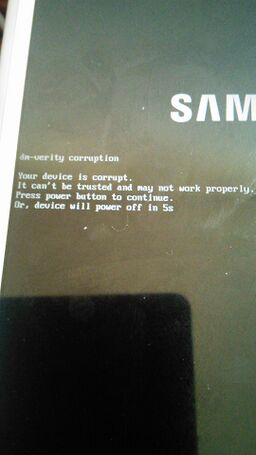Samsung Galaxy Tab A7 Lite (samsung-gta7litewifi)
| This device runs a Downstream kernel. Some UIs will not work, and most features (3D acceleration, audio, etc.) may be broken. |
 The postmarketOS "Loading..." screen on a Samsung Galaxy Tab A7 Lite | |
| Manufacturer | Samsung |
|---|---|
| Name | Galaxy Tab A7 Lite |
| Codename | samsung-gta7litewifi |
| Released | 2021 |
| Type | tablet |
| Hardware | |
| Chipset | MediaTek Helio P22T (MT8768) |
| CPU | ARM Cortex A53 MPCore |
| GPU | PowerVR GE8320 |
| Display | 800x1340 TFT LCD |
| Storage | 32GB or 64GB, depending on the specific model |
| Memory | 2GB, 3GB, or 4GB, depending on the specific model |
| Architecture | aarch64 |
| Software | |
Original software The software and version the device was shipped with. |
Android (One UI) 11 |
Extended version The most recent supported version from the manufacturer. |
Android (One UI) 14 |
| FOSS bootloader | no |
| postmarketOS | |
| Category | downstream |
Mainline Instead of a Linux kernel fork, it is possible to run (Close to) Mainline. |
no |
pmOS kernel The kernel version that runs on the device's port. |
4.19.191 |
Unixbench score Unixbench Whetstone/Dhrystone score. See Unixbench. |
0.0 |
| Device package |
|
| Kernel package |
|
Flashing Whether it is possible to flash the device with pmbootstrap flasher. |
Works
|
|---|---|
USB Networking After connecting the device with USB to your PC, you can connect to it via telnet (initramfs) or SSH (booted system). |
Works
|
Internal storage eMMC, SD cards, UFS... |
Works
|
Battery Whether charging and battery level reporting work. |
Broken
|
Screen Whether the display works; ideally with sleep mode and brightness control. |
Partial
|
Touchscreen |
Broken
|
| Multimedia | |
3D Acceleration |
Broken
|
Audio Audio playback, microphone, headset and buttons. |
Broken
|
Camera |
Broken
|
Camera Flash |
Broken
|
| Connectivity | |
WiFi |
Broken
|
Bluetooth |
Broken
|
Ethernet |
Works
|
GPS |
Broken
|
| Miscellaneous | |
FDE Full disk encryption and unlocking with unl0kr. |
Works
|
USB OTG USB On-The-Go or USB-C Role switching. |
Works
|
| Sensors | |
Accelerometer Handles automatic screen rotation in many interfaces. |
Broken
|
Magnetometer Sensor to measure the Earth's magnetism |
Untested
|
Ambient Light Measures the light level; used for automatic screen dimming in many interfaces. |
Broken
|
Proximity |
Untested
|
Hall Effect Measures magnetic fields; usually used as a flip cover sensor |
Untested
|
Haptics |
Untested
|
Barometer Sensor to measure air pressure |
Untested
|
Power Sensor Sensor to monitor current, voltage and power. Not fuel gauge! |
Broken
|
| WARNING: Make sure that you are prepared to lose functionality before installing postmarketOS. Samsung Knox will blow an efuse when the OS is modified that will permanently disable Knox-only features like Samsung Pay, and you will NEVER be able to use those features again. |
| WARNING: Make sure to create a backup of the internal storage on your device before proceeding! |
| While the kernel compiles and flashing is available, this device is in an extremely early state of development. Here Be Dragons |
Contributors
hexaheximal
Users owning this device
- A-Australian (Notes: have two, one with a Voltage GSI and another with an Idode GSI, both rooted, however one has a cracked screen, purely cosmetic)
- Hexaheximal (Notes: maintaining the postmarketOS port, 3GB RAM 32GB eMMC model)
- IOrbitSaturn (Notes: T220, currently running postmarketOS Edge for testing :3)
- Sf97ahgf (Notes: Running Lineage GSI)
- Zillion (Notes: T220, Currently running OneUi for kernel development)
Status
This postmarketOS port is incredibly buggy, but does boot.
The only known working desktop environment option is i3, but the touchscreen does not work. XFCE just causes a crash-reboot.
Unlocking the bootloader
At least at first, the Android settings app does not allow you to enable bootloader unlocking. (On some devices it requires that it can connect to Samsung's servers first, but I would not recommend ever connecting it to the internet on stock Android)
However, it can be done with mtkclient:
$ mtk e metadata,userdata,md_udc
$ mtk da seccfg unlock
If it worked you should see a warning like this:
Do not panic! Your device is not broken!
If you *don't* see that warning, then it didn't work.
You can safely skip the warning, although on stock Android it might fail to boot in which case you will need to choose the factory reset option to clear userdata etc. again.
Installation
Using pmbootstrap
Install pmbootstrap and then run the following commands:
$ pmbootstrap init
$ pmbootstrap install
$ pmbootstrap flasher flash_kernel
$ pmbootstrap flasher flash_rootfs
Manual install
In case pmbootstrap fails to install for any reason, the manual install has also been tested
Reboot into fastboot mode and run the following commands:
$ pmbootstrap init
$ pmbootstrap install
$ pmbootstrap export
$ cd /tmp/postmarketOS-export/
$ fastboot flash boot boot.img
$ fastboot erase system
$ fastboot flash userdata samsung-gta7litewifi.img
$ fastboot reboot
If the commands were successful, you're ready to use postmarketOS!
Reading logs
Before reading the logs, make sure to install mtkclient and then erase the expdb partition so the existing boot logs don't get mixed in and get confusing:
$ mtk e expdb
Once you have done that, boot the device. As soon as it powers off during a bootloop (and if it doesn't, hold down Power + Volume Down for ~10 seconds), run these commands:
$ mtk r expdb /tmp/expdb.bin
$ mtk reset # turns the device off, optional
$ cat /tmp/expdb.bin
Please note that the kernel part of the logs is quite a mess - it does not use proper newlines and instead uses what seems to be null bytes.
Downstream kernel status
The downstream kernel is surprisingly capable, but still lacking in many ways. For example, audio is currently broken and the touchscreen does not fire any events. However, if you use a USB-C OTG dock to connect it to a keyboard & mouse, it works perfectly fine. Ethernet works fine if you do it that way too.
Mainline kernel status
The MT6765 close-to-mainline kernel does not boot due to the android bootloader refusing to boot with a dummy dtbo.
Working Desktop Environments
| Desktop Environment | Working Status | Details |
|---|---|---|
| None | Partially | Does react to commands and things, does not output anything |
| Buffyboard | Not Working | Does not boot at all |
| Console | Partially | Responds to commands, does not output video |
| fbkeyboard | Not working | Does not boot at all |
| Gnome | Unknown | Untested |
| Gnome Mobile | Unknown | Untested |
| i3wm | Working | Mostly working, some gestures can crash-reboot the device |
| Lomiri | Unknown | Untested |
| LXQT | Not Working | X11 starts and displays the cursor for a while until the device crashes, not working at all |
| MATE | Not Working | Does not boot at all |
| MediaBerry | Unknown | Untested |
| Moonlight | Unknown | Untested |
| OpenBox | Unknown | Untested |
| OS Installer | Unknown | Untested |
| KDE Plasma | Unknown | Untested |
| Shelli | Unknown | Untested |
| SXMO de DWM | Unknown | Untested |
| XFCE4 | Not working | Device crash-reboots when starting, not working at all |
The reason as to why they crash might be related to the desktop environment calling QT instructions, which they apparently don't play well with the kernel and ends up crash-rebooting the device
See also
- pmaports!4627 Initial merge request
- This post on Mastodon, which was made and published on this postmarketOS port
- lowendlibre
- MTKClient
